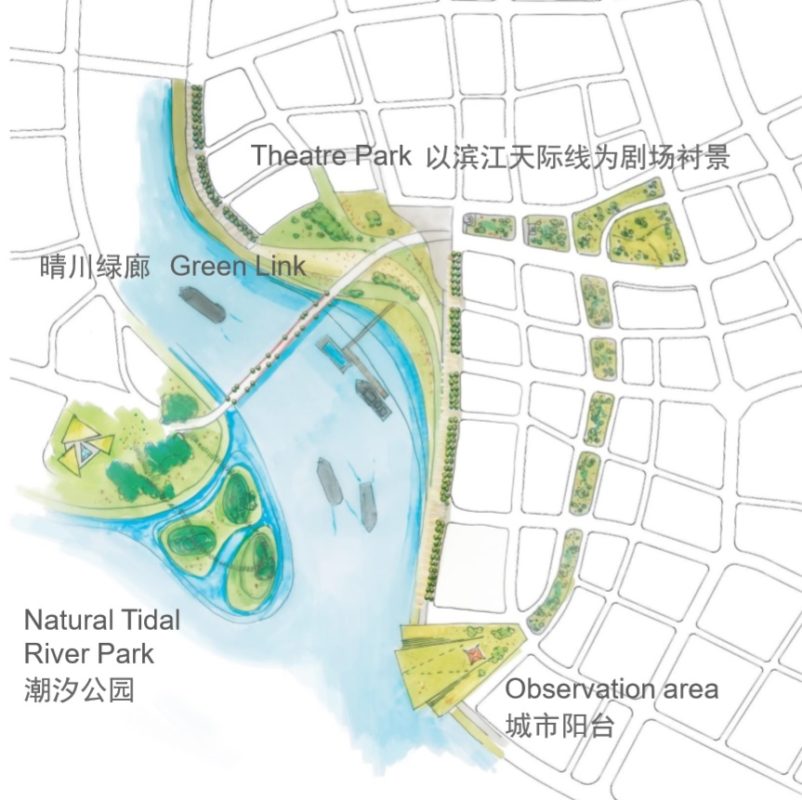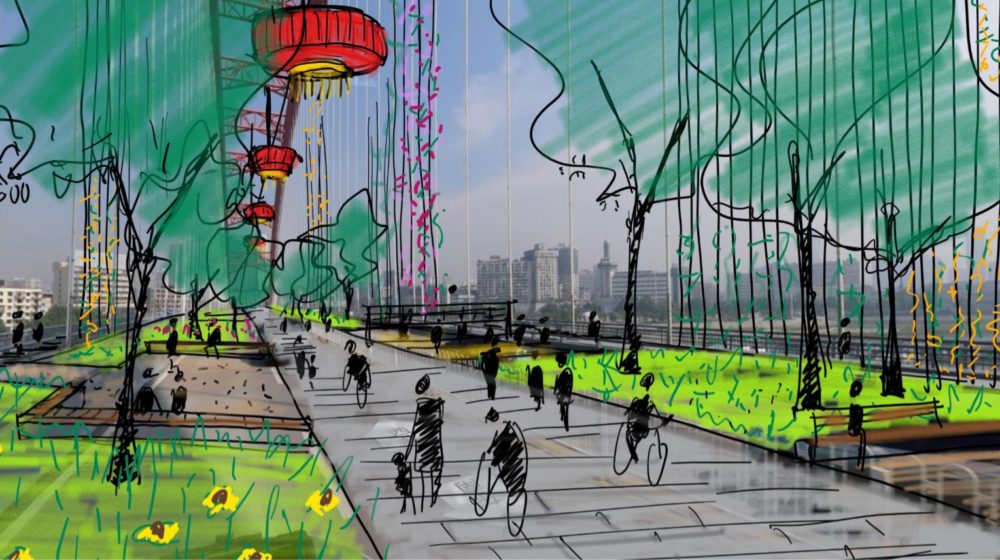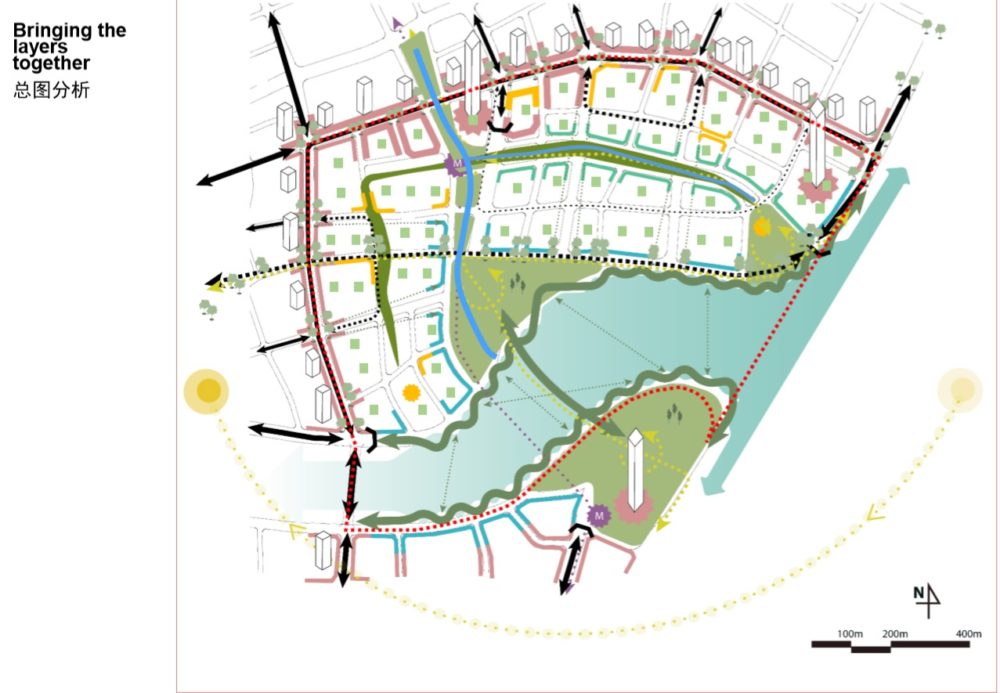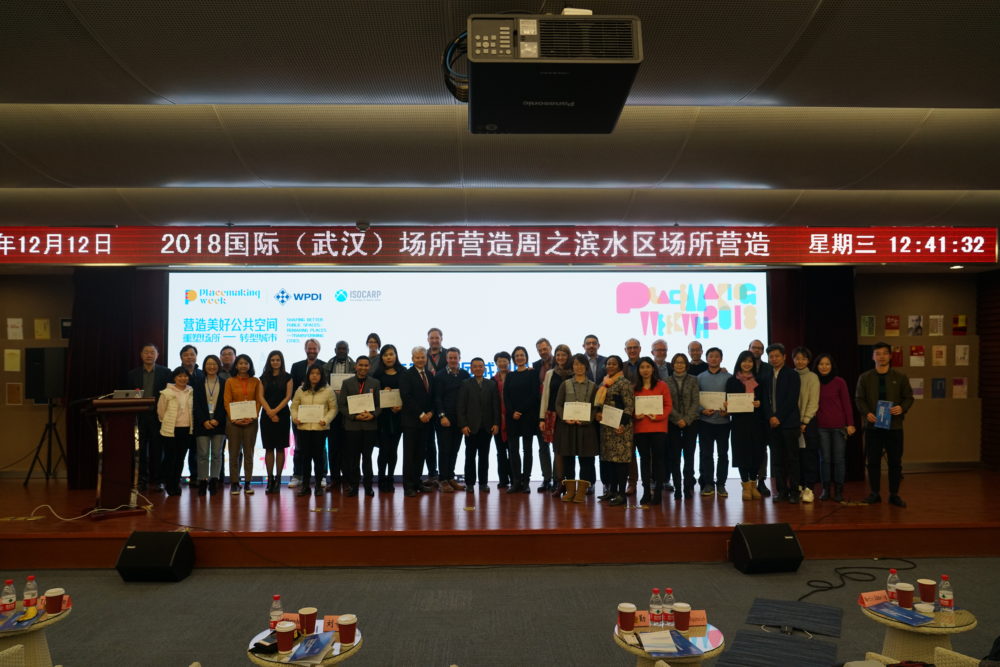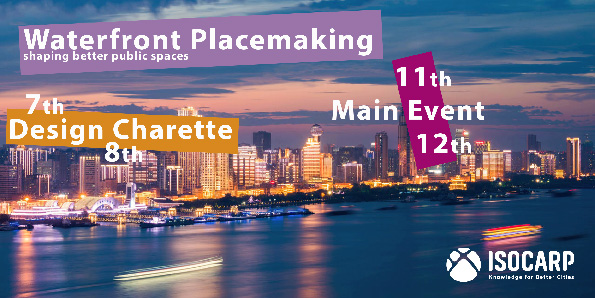
As an official partner, ISOCARP is co-organising one of the sub-themes of the Wuhan Placemaking Week (WPW), Waterfront Placemaking, which focuses on making better public spaces along Wuhan’s riverfronts. The WPW will kick-start the Chinese Placemaking Network, but will close the year for Placemaking Weeks, a global movement and innovative social event that emphasize hands-on learning while leaving behind a public legacy in host cities.
Our team of experts, recruited across ISOCARP’s global network, will contribute to placemaking by a creative Design Charette on the development of ‘New Hanzheng Riverside Avenue’ with some 900-meter long riverfront coastline at the confluence of Hanjiang and Yangtze rivers, while six distinguished colleagues will be moderating, leading teams and speaking at the main event.
Wuhan, like other Chinese cities, has grown at tremendous speed, especially since the country’s economic rise in the past 40 years. China is entering a new phase: old functions cannot meet the requirements of new urban development and thus improving the urban public space, by means of placemaking, is becoming central to urban renewal. But placemaking in China is more than just beautifying cities. It is about creating new collaborations between officials, professionals, and communities.
![]()
Blog on the #PlacemakingWeekWuhan by Balint Horvath
December 12.
At the last day, participants at the Wuhan Placemaking Week split up again into the four sub-themes and it was time for the Design Charette team, presented by Milena, to expose their results on the New Hanzheng Riverside Avenue to the invited guests and the public.
Milena’s presentation began with addressing one of the challenges of developing public spaces, how placemaking can manage gentrification, and advised planners and policy-makers in the audience to pursue inclusive and sustainable growth strategies: creating places that enhance the existing social, cultural, economic, and natural characters of the historic Hanzheng District and riverside, instead of erasing them. Accordingly, our roadmap also emphasized community engagement and local asset mapping as a benchmark for urban renewal and balanced development, supported by eight principles, which are vital for placemaking:
- Waterfront enhancement
- Encourage mix of uses
- Permeable block network
- High quality public space
- Complete streets for multiple modes
- Human-scale design
- Identity and sense of place
- Protect built historic heritage
In the Hankou area, the Design Charette team identified three strategic interventions, which would ground balanced development: improve mobility, support new creative economies, and establish waterfront as a place for everyone. While some measures like introducing traffic filters, or traffic sectors, have a narrower purpose, others like reimagining the Quingchuan ‘Rainbow’ Bridge as a green link across the Han River have complex objectives in terms of urban mobility, spatial connectivity, local identity and landmarking for the district. Regarding local economic development, participants took the dense network of bulk markets, logistic centres and small businesses in Hankou as their starting point and explored how new, creative economies could supplement livelihood opportunities.
These development plans came together with waterfront placemaking and design strategies most visibly at the Wuhan Central River Park, which was suggested as a new public park at the junction of the Jangtze and Hun rivers. The River Park would not only complete the Y-shaped network of urban green spaces at the left bank of the Hun River. But it would also integrate both riverbanks into one entity, via the Rainbow Bridge, with a natural tidal park at the confluence. By creative landscaping, the team illustrated, the robust dykes could be reclaimed for waterfront placemaking that respond to water-level rise without compromising on its crucial function as a flood protection. Meanwhile, participants also recommended to encouraging mixed land use and permeable block design, which would lend the new business district diverse characters and allow for various activities.
Therefore, the Design Charette team made an important contribution to frame waterfront placemaking in the New Hanzheng Riverside Avenue as an opportunity to utilise the rich socio-economic and cultural values in the district. And, by planning with water, rather than against, the River Park would add new urban functions to the city and Hankou would gain a distinct identity as a vibrant and attractive centre of Wuhan.
December 11.
In his speech, Martin has encouraged young planners to go abroad and network with colleagues in other cities. Not only to exchange best practices and build professional capacity, but also to become aware of those ideas, which should be “appreciated from your own city and region”. ISOCARP’s support for the Wuhan Declaration affirm his message, for the Declaration is a both a testimony of international cooperation for the betterment of public spaces across China as well as a recognition of Wuhan’s commitment to place-led urban development and placemaking locally.
Caroline has drawn inspiration from her experience as the co-founder of UN Studios and being Dutch for her message to placemakers: be collaborative, see water as an opportunity and design with detail and social sensitivity. Her presentation has illustrated how infrastructure projects, like the iconic Erasmus Bridge in Rotterdam, can turn into placemaking and symbol for cities. Furthermore, she has excited the audience by sketching out how innovation and technology can play a role in placemaking: as a product and as a planner’s toolbox to investigate how people engage with their environment and to enhance their experience of public spaces.
December 10.
While the Design Charrette team is preparing their final presentation, our distinguished speakers are getting ready for the Plenary and Breakout Sessions on #WaterfrontPlacemaking tomorrow. Lets shine a spotlight on the two keynote speakers!
Caroline Bos from the Netherlands. Caroline Bos is an architect and a co-founder of UNStudio, a large award-winning architecture firm in Amsterdam. Caroline writes and has taught as a guest lecturer at Princeton University and the Berlage Institute in Rotterdam, among other institutions. Her architectural drawings and models are shown at museums like MoMA. She studied History of Art at Birkbeck College of the University of London and Urban and Regional Planning at the Faculty of Geosciences, University of Utrecht. In 2012 she was awarded an Honorary Professorship at the University of Melbourne’s Faculty of Architecture, Building and Planning.
Martin Dubbeling from the Netherlands. Martin Dubbeling is the President of ISOCARP and he is an urban planner and designer, specialised in sustainable urban design. In 2013 he founded Connecting Cities, office for research, consultancy, design and communication in sustainable urban and regional planning. As an all-round practicioner, he has extensive experience both in the Netherlands and internationally in Singapore, China (Wuhan, Nanjing, Shantou, Ningbo, Guangzhou), Russia (Perm), Gaza and the West Bank, Norway (Bodø) and South Africa (Durban).
December 8-9.
Following the site visit, our team leaders, Frank, Michael and Deborah, have asked the 20 participants to regroup into sub-teams according to three spatial scales through which we are investigating strategies for the New Hangzhou Riverside Avenue: from city to district to street-level. While these scales are conducive to frame “how public space compliments wider city strategy”, the Design Charrette also infuse planning principles from global policy frameworks, the New Urban Agenda, SDGs, Paris Agreement, into our placemaking strategies: climate resilience and climate impact; multi-modal transport planning; liveable densities; inclusive housing and public space design; and heritage-based redevelopment – some of which are reflected in Wuhan’s spatial development strategy too.
Especially with regards to public space design, team leaders have encouraged us to build on the lessons of the Wuhan UPAT workshop in 2017, which promoted a people-centred, integrated approach to heritage-based placemaking along the Zhongshan Avenue. The “one street, one regime” strategy, then proposed by the UPAT experts, aimed at eliminating administrative, design and management boundaries for successful placemaking. And now, the Design Charrette teams should draw on this strategy and extend it from one street to a network of streets in the New Hangzhou area.
Looking at it from the city-level, the first team has researched how the site connects with the broader economic, social and spatial context of Wuhan, concluding that the site lies “at the heart of the city”. At the macro-scale, the confluence of the two rivers lends a natural centrality to Riverside Avenue, so does its position within Wuhan’s first mobility ring and historical core. At the micro-scale, major tourism and commercial hubs intersect at the area, which creates a local identity and vibrancy along the axis of retail and wholesale centres. While planning the new business district, these are important points to consider how to keep Wuhan’s unique identity yet maintain its world city aspiration.
The team, led by Michael, has come to similar observations at the district and street scales. Just by scratching the surface of the diverse cultural and social assets in this area, his team began to map out a character design for different urban blocks, which also reflect participants’ planning principles for placemaking, for example green, permeable, walkable blocks and streets. Their vision does not only call for redistributing density or diversifying building typologies. But it also enlarges the focus on the confluence and the river edge to include the wider neighbourhood. Consequently, what they envision is a Wuhan Central River Park that would connect not only the local socio-economic and cultural places to the waterfront, but also both shorelines of the Hun river via the ‘Rainbow Bridge’, which are otherwise disconnected.
This vision for a River Park and a network of green spaces fit well with the expertise of the third team, led by Deborah, who are utilising landscape design to actualise these connections and create new nature-based urban functions, and find a remedy for the 17 meters fluctuation of the two rivers in between low flow and high flooding. Or in Deborah’s words “prepare for flooding but design for draught”.
On Tuesday, we will see how all these great ideas converge!
December 7.
With the warm welcome of the Wuhan Planning and Design Institute (WPDI), the Design Charrette has started its three-day long intensive program today. During the morning session, colleagues from the WPDI presented their project background, which gave us a taste of the complexity and challenges awaiting at the site. Traditionally, the Hanzheng Avenue was a a “place of commerce and diversity” where the confluence of the Yangtze and the Han rivers gathered people from every corner of China. However, due to the urban transformations taking place in the past two centuries, the historic structures were replaced by new ones, giving way to widening streets and a robust dijk system along the shoreline. Simoultaneously, as a result of population and economic growth, the area and public spaces became overburdened and crowded.
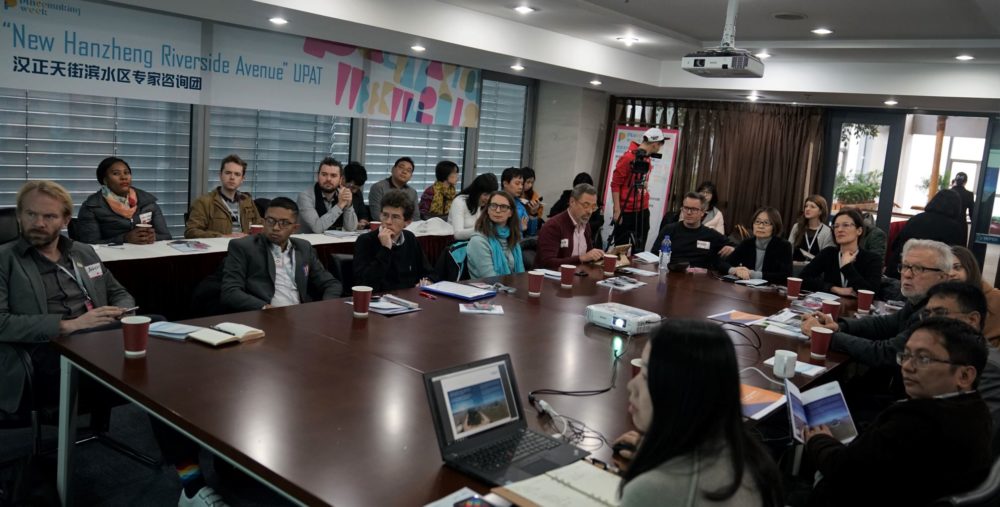
Today, however, the municipality’s vision for the Hanzheng area is projecting a rise. And much of what we have seen during the site visit, will be transformed into Wuhan’s news urban core, characterised by global trading, financial and tourism sectors.
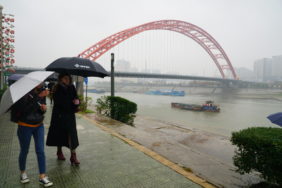
For placemaking at the New Hanzheng Riverside Avenue, this is posing some difficult questions: how to integrate the historic sites into the newly proposed urban context; how to reconcile the need for flood protection with placemaking for a livable and accessible riverfront; and how the rivers could serve as connectors between the new avenue and the rest of Wuhan. ISOCARP team leaders were also critical about the parameters of the redevelopment site and whether by tweaking the proposed boundaries under the master plan, landscaping could create more natural flows and harmonious connections.
Having these considerations in mind, the Design Charrette teams will develop new design strategies for intervention at the city, district and street-level, and hence bring back the old spirit of the Yangtze and Han rivers to waterfront placemaking in Hanzheng: to become once more a place of meeting point and exchange.
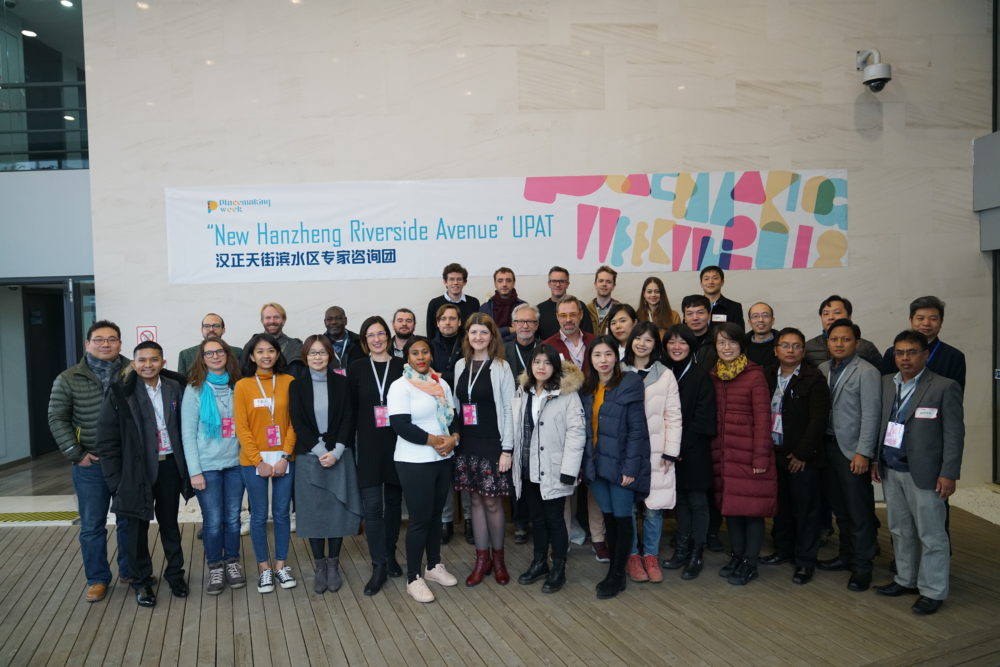
December 6.
In the past days I have shared background information on Wuhan’s urban planning and waterfront development. But how much do you know about the ISOCARP members behind our Design Charrette? Today I would like to put the #WaterfrontPlacemaking team leaders in the spotlight!
Deborah Lamberth from Belgium. Trained as an landscape architect, Deborah brings a wealth of professional experience on water-related, public space design both from the public and private sectors. Her work for the Amsterdam municipality to redevelop a former industrial site into a riverside park and residential area along the Amstel river is just one of the many experiences. As a co-founder of Felixx, Deborah nowadays is more internationally-oriented. She has led landscape and planning projects from creating nature-built, temporal islands on the Osum River in the city of Berat, to taking a street-led approach on water and sanitation upgrading in Mumbai, to redeveloping an old industrial harbour by the sea under Reykjavik’s 2040 masterplan.
Michael Stott from Canada. Michael is an experienced urban designer and planner with a diverse range of project expertise from small-scale to large-scale urban development and master plans. In the past 18 years, he has worked in China, Europe, Central Asia, North America, and the Middle East where he has focused on design solutions that put people and communities at the centre of the physical environment. Michael is also the Director of Ethos Urban, an Australian-based company, which has delivered several projects in the waterfront development sector.
Frank D’hondt from Belgium. As an urban geographer and planner, Frank has a 25 year-long career in advising local, regional and national governments on sustainable urban planning in Kenya, Nepal, Afghanistan, the Caribbean among other places. Recently, Frank has co-published Handbook for the application of the International Guidelines on Urban and Territorial Planning with the UN-Habitat, which helps local governments implement the New Urban Agenda and the Sustainable Development Goals, and rethink city and metropolitan planning. He is also the founder and managing director of Territorial Capital Institute.
December 5.
Landed! Today I am visiting Guangzhou, where I was welcome by local ISOCARP members. Tomorrow I take the train to Wuhan where I join the program of the Design Charrette, an official pre-event of the WPW:
Thursday /6/ the international team arrives
Friday /7/ on-site project brief and brainstorm for waterfront placemaking
Saturday /8/ finalising design plans for the New Hanzheng Riverside Avenue
December 3.
While looking at the riverfront site, I am becoming more curious how my colleagues will adopt the six principles of waterfront planning at this challenging location. Four days before the start, I wonder what the site-specific opportunities and limitations are that Google Earth cannot tell. And how will the Design Charrette, a collaboration of diverse stakeholders to generate a future vision, complement placemaking as a process for transforming public spaces. I cannot wait to find out the answer to these questions!
November 29.
Although the WPW will be my first time in Wuhan, Wuhan is well know to ISOCARP. In the past seven years, the city hosted our Young Planning Professional’s Program, the 47th Annual Congress, the Urban Planning Advisory Team and next week we will return once more with a great Design Charrette! Would you like to know more on how my colleagues have helped to shape the capital of Hubei province, join me reading our Plan magazin on transforming Zhongshan Avenue District.
November 26.
As my arrival date to Wuhan is within sight, the preparation to make the Design Charrette a joyful event has come to its final stage. Passport, visa and my reading list for the long-flight: an exciting story on one of Wuhan’s riverfront oases, the Hankou Jiangtan Park, complimented by ISOCARP’s own publication on how planning can manage the vital relationship between water and cities. I am looking forward to the take off next week!
WPW is jointly organized by UN-Habitat and Wuhan Land Use and Spatial Planning Research Centre, in collaboration with ISOCARP, Project for Public Space, Wuhan Planning and Design Institute, Asian Habitat Society, Wuhan University, and the Huazhong University of Science and Technology

